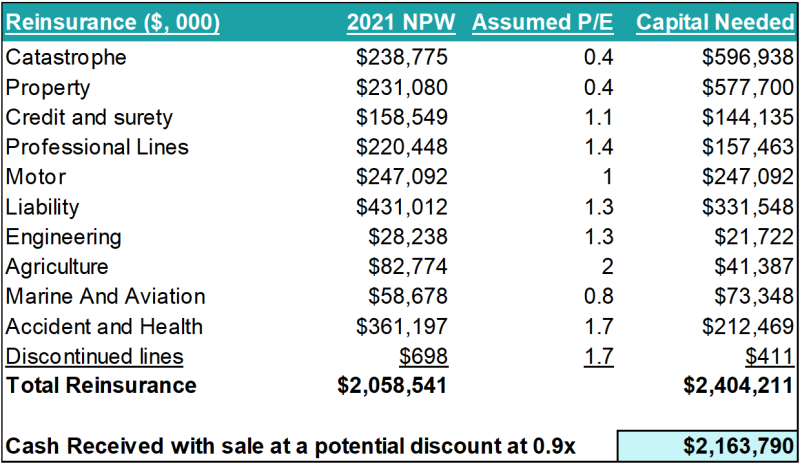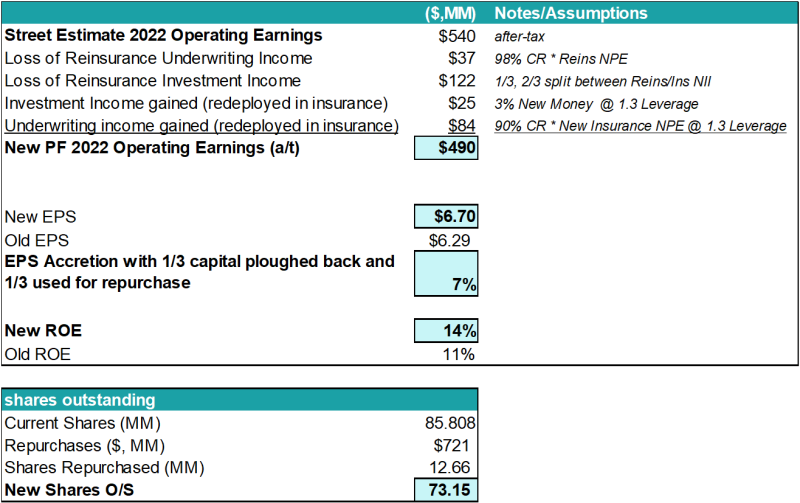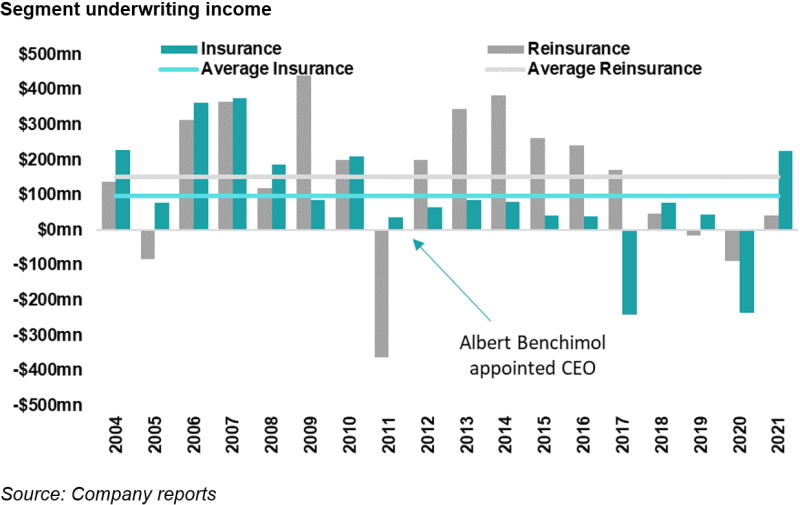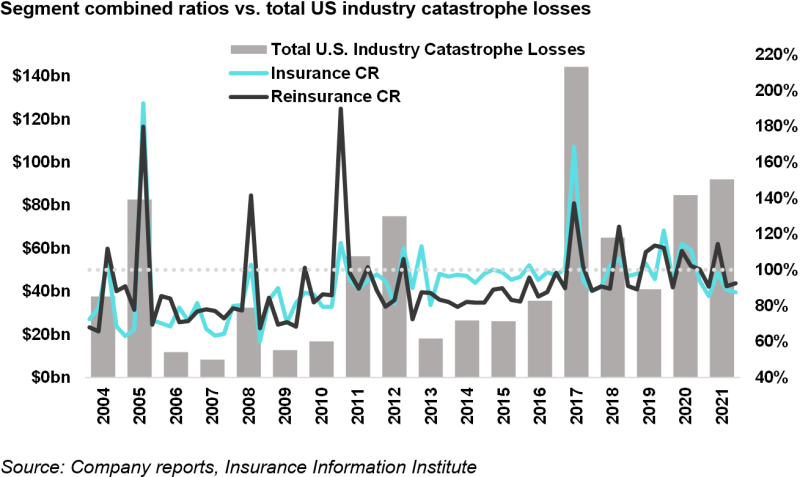In response to a question, Buffett described how the Alleghany deal came about and suggested that serendipity played a part in the chain of events leading up to the acquisition. If the timing was not right, perhaps the deal would not have happened.
Last week our news team disclosed that Axis Capital was looking to shop its reinsurance business for a potential sale. To be clear, Axis refused to address the story directly on its subsequent earnings call.
However, taking a step back, this industry's reinsurance space has undergone a meaningful evolution from being a desirable sub-sector following significant catastrophe events in the early to late 2000s to mainly being out of favor due to the recent volatility.
This volatility has led to underperformance, investors souring, and discounted valuations for the publicly traded names. So unlike Berkshire-Alleghany, where a unique confluence of factors led to the decision, for Axis a sale of the reinsurance business would be a culmination of the factors outlined above.
Another thing to remember is that this is not the first time Axis (parts or whole) has been in the news for a potential disposition. In my past life, one of the persistent questions from investors was what role Axis would play as an acquirer or acquiree. Our piece, where have all the reinsurers gone, discussed the challenges smaller franchises face with every step being second-guessed by outsiders.
For Axis, like other franchises, reinsurance volatility has become a valuation albatross. Hence, we’re not surprised to see the news that the company was looking to unhitch the reinsurance business.
Additionally, current CEO Albert Benchimol’s employment agreement is up for renewal in 2023, so that timeline may also play a role. A disposition of a relatively underperforming asset and a sale of the remaining insurance business down the road for a good multiple would be a nice feather in the cap for Benchimol.
The chart below shows a persistent valuation gap between best-in-class RenaissanceRe and others. It's also fascinating to note how small this cohort has gotten over the years through mergers and consolidations.

The note below looks at the value received from a potential reinsurance sale, what to do with those proceeds and their impact on annual earnings, and the relative performance of the businesses.
Firstly, a sale of the reinsurance business could generate ~$2bn of proceeds.
The first step in this analysis was to develop the level of capital backing for the reinsurance business since it is not fully disclosed in the SEC filings. The table below looks at the various subsegments within the reinsurance business and assumes capital supporting it to develop an approximately $2.4bn number. This calculation is one way to look at it and is quite back of the envelope. Any potential buyer would have access to a deeper dive sub-line of business and reserving data.
After coming up with a capital number, we have applied a discounted multiple to the sale. Our thought process factors in how quickly Axis plans to dispose of this asset and the fast-approaching hurricane season.
A buyer might otherwise drag it out beyond the peak of the season or build in some other safeguards. On the flip side, a buyer looking to deploy capital and build upon the base could also pay a decent premium for this book, so the 0.9x is more of a starting point for this analysis.
This analysis leads us to receive $2.1bn-$2.2bn of proceeds at the lower end.

Secondly, it is likely that the cash received could be deployed into multiple avenues, including a special dividend, repurchases, and/or plowed back into the insurance business.
We find it unlikely that the company will sit on the cash or spend all of it buying back stock on the other end.
Depending on the available market opportunities, there could be multiple options for this deployment. For simplicity, we have assumed a three-way split between the options. The actual actions could include all or none of these options, and we are mindful of the tax implications of a special dividend.

The exhibit below takes the Street earnings for 2022 and applies several adjustments to develop a pro forma estimate for 2022. (The adjustments are detailed at the end of the note.)
The analysis points to a base case of a special dividend of $8.41/share, a repurchase of 12.7 million shares, and earnings accretion of 7%.
As a result, an ROE of 14% vs prior of 10%-11% should start moving Axis’ stock multiple to a class-leading number and, if results remain stable, could end up fetching a decent multiple in any subsequent consolidation scenario.

Thirdly, reinsurance volatility has continued to rear its head in recent years.
Over the past five years, as the frequency of severity of losses has changed, investors in these companies have been less accepting of the consequent volatility.
Two things have led to this evolution.
Firstly, with the advent of third party and external capital, pricing pressure has squeezed returns. As a result, catastrophe classes can no longer subsidize other low-return classes.
Secondly, even though the industry has seen substantial volatility, industry capital has continued to recover due to the broadened class of reinsurers vs 2001 or 2005. There was a very real capacity crunch at that time, and new companies were needed. But with capital mostly abundant, pricing power has diminished.
With the risk/reward matrix shifting, reinsurance-predominant companies facing earning volatility have gotten sold/acquired or pivoted to a hybrid model. For Axis, reinsurance had several great years, just before and for a period after Benchimol’s arrival. However, the volatility of results has continued to rear its head now and then.

This volatility has continued to play a role in how the company has discussed results in the reinsurance segment.
For example, Benchimol, in his first letter in the annual report in 2012, noted: “In response to some of the early events, we initiated an entire re-evaluation of our portfolio of catastrophe exposures, as well as our appetite for this class of risk.
“Axis Re is well-positioned to benefit from the rising rate environment that we expect to witness across many classes of reinsurance in 2012. We are absolutely determined to return to strong profitability during the current year.”
In 2021, some of the same issues were dogging the company when Benchimol noted in his annual report letter: “Axis Re also delivered improved performance, and it is an encouraging sign of progress that in a very high cat year for the industry, it produced a combined ratio below 100%.
“In addition, the current year ex-cat combined ratio of 86.3% was the best since 2012. This demonstrates that the work our team has done to improve the quality and resilience of our reinsurance portfolio is paying off.”
The chart below is an interesting exercise. It shows the combined ratio for both segments and overlays US catastrophe losses on top. Although industry losses have shown significant volatility, Axis’s combined ratios have remained elevated and range-bound, perhaps leading management to believe a more radical course of action was needed.

It’s one thing to be interested in finding a buyer for a business. It is another thing when the business in question is a reinsurance franchise. Are there many buyers looking for a reinsurance business at this stage? Who are the natural buyers of this business?
On an unrelated note, Argo recently disclosed that it was examining strategic actions, including an entire disposition which we covered in a prior write-up.
That note highlighted the list (shown below) of potential buyers for Argo apart from likely private equity interest. One can probably add RenRe, PartnerRe and Scor to the list and omit some businesses known to be skeptical on reinsurance acquisitions like Tokio Marine, Allianz and Everest Re to generate an Axis Re list.
The buyer often emerges from the left field, as we have seen for several acquisitions, including XL, PartnerRe, Aspen, and Validus Re. One should not be surprised to find a non-traditional purchaser if this disposition does happen.
It is unclear what impact two different businesses being shopped out there will have on having at least some overlapping interest from potential buyers.

In summary, this might be a good time to press the accelerator on strategic decisions as we head towards the catastrophe season coupled with an unclear economic outlook and its impact on the (re)insurance industry.
Addendum on methodology
Adjustments to generate pro forma 2022 financials for Axis:
1. 98% combined ratio applied to 2021 earned premium to come with an estimate for 2022 reinsurance earnings lost. Reinsurance combined ratios have shown extreme volatility, as shown on the next page, which makes us believe our estimate could be conservative.
2. We have apportioned the investment income as 2/3 in insurance vs 1/3 in reinsurance due to the tail of those business segments since these details are not broken out in the earnings/supplement.
3. We have applied a 3% new money yield for the new insurance premiums being written at 1.3 premium to equity on the plowed back capital of $721mn.
4. We have assumed that the new insurance premiums run at a 90% CR on an ultimate basis.
5. We have assumed 1/3 of the proceeds are used for repurchasing shares, which gives us 12.7 shares bought back at the latest price. Therefore, for EPS and ROE, the equity and share counts have been adjusted accordingly.

